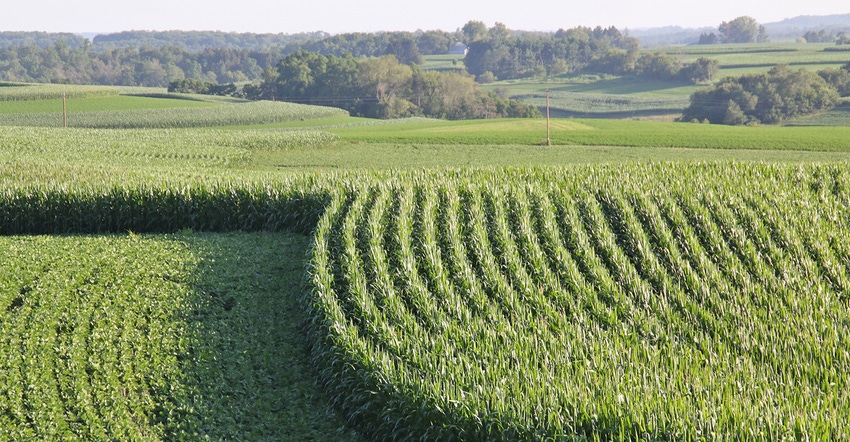August 28, 2017

By Jerry Clark
The 2017 growing season was a challenging one. Most of Wisconsin received steady rains during the planting season, which led to delayed planting or replant situations. Those early-season delays are now starting to present another set of challenges as we find uneven fields of corn and soybeans with different moisture levels throughout the field. Managing and handling the grain from these fields correctly will lead to better storage conditions and grain quality.
Uneven corn
One of the biggest challenges of harvesting uneven corn is keeping the combine adjusted properly. It is not uncommon to lose 10% to 15% of grain yield when operating a poorly adjusted combine. Variable ear and kernel sizes typically encountered in uneven fields make it difficult to keep grabber rolls on the combine head properly adjusted. Uneven kernel development means fan windblast must be monitored and adjusted to prevent lighter kernels from blowing out the back of the combine.
Late-planted corn will likely have higher moisture. Higher grain moisture at harvest increases kernel damage and drying costs. All corn harvested from uneven fields should be dried to a suitable moisture content for long-term storage. Immature corn killed by frost will have a different drydown rate than more mature corn. The rate of kernel drydown for immature corn killed by frost is determined by the individual hybrid. Corn planned for long-term storage should be stored at 13% moisture. If corn is to be stored for six months or less, then 15% moisture is the target.
Later-developing plants will most likely have smaller stems, weaker stalks and fewer brace roots, so the potential for lodging is higher. Harvest losses have the potential to be higher in later-planted fields due to lodging if the combine’s speed is not reduced. Measuring harvest losses is always important for making proper combine adjustments, and it is even more important in fields with uneven moisture levels and kernel sizes.
Preharvest losses
Preharvest losses can be higher in uneven fields as you wait for most of the field to reach maturity or a lower moisture to save on drying costs. The hybrid has a lot of influence on the amount of preharvest loss. If moisture range is large in a given field, some drier cobs may drop.
One dropped ear (three-quarters of a pound each) in each 1/100 of an acre is equivalent to about 1 bushel per acre. To determine 1/100 of an acre, take the normal 1/1,000 of an acre distance times 10. For example, in 30-inch rows, 1/1000 of an acre is 17 feet, 5 inches; 1/100 of an acre would be that distance across 10 rows. For each dropped ear in that area, there is 1 bushel per acre of loss. The longer the field stands to achieve proper harvest moisture, the more risk of weather and lodging playing a role in creating poor harvest conditions.
Another area of loss is what we call gathering losses, or grain that does not get into the combine. To determine these losses caused by the header, count the number of ears and kernels under the header. Two kernels per square foot are equal to 1 bushel per acre of loss. More than a half-bushel per acre (or one kernel per square foot average) indicates adjustments are appropriate.
Stubble losses and stalk losses where the cob is either missed or shattered but is not making it into the combine indicates the header and speed need to be adjusted. Immature plants with smaller, weaker stalks have the potential to lodge and be missed by the combine. Be sure to look for these plants when estimating harvest loss.
Machine losses come from improper adjustment of threshing, separating and cleaning sections of the combine. Threshing loss is indicated by kernels attached to pieces of cob behind the combine. These were not shelled by the rotor or cylinder. Separating losses are additional loose kernels on the ground behind the combine. These were not shaken out of the cobs and husks and were lost over the back of the separator.
These adjustments may need to be made more often when harvesting uneven fields with varying moisture levels. The average harvest loss is 0.6 to 2.5 bushels per acre. The goal is to be less than a half-bushel per acre. Can you get there?
Clark is the Chippewa County Extension crops and soils agent.
How to measure losses
Determine average loose kernel loss and cylinder/rotor loss by keeping these things in mind:
• every 2 kernels per square foot = 1 bushel per acre
• kernel still attached to cob = cylinder/rotor loss
• acceptable level = 1.2 to 3 kernels per square foot
Determine machine ear loss. Behind the combine, gather all ears on 1/100 acre. In front of the combine, determine preharvest ear loss in standing corn on 1/100 acre. Subtract preharvest ear loss from ear loss at the rear of machine.
• each 3/4 pound ear = 1 bushel per acre
• each 1/2 pound ear = 2/3 bushel per acre
• acceptable level = 0 to 1 bushel per acre
Typical level of loss equals 0.6 to 2.5 bushels per acre. Can you limit your total field loss to less than a half-bushel per acre? That would place you and your combine in the top 10%.
You May Also Like




